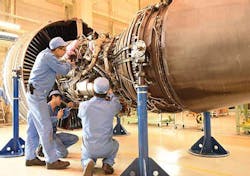DOE taps Raytheon Technologies to test H2 and Ammonia as power resources
The U.S. Department of Energy has selected aerospace conglomerate Raytheon Technologies for testing the use of hydrogen and ammonia as clean power sources.
One of the two research and development projects will see Raytheon using hydrogen and hydrogen blends as fuel sources to operate Mitsubishi Power Aero's FT4000 gas turbine unit, which is a land-based version of Raytheon subsidiary Pratt & Whitney's PW4000 turbofan aircraft engine (pictured).
The hydrogen fuel test will complement another U.S. DOE-backed project – Hydrogen Steam Injected, Inter-Cooled Turbine Engine (HySIITE) which is led by Pratt & Whitney. HySIITE focuses on the development of hydrogen-fueled propulsion technology fit for single-aisle commercial aircraft.
"Hydrogen has an important role to play in enabling the aviation industry's pathway to net zero emissions, and we are focused on developing technologies to maximize the potential opportunities that this zero-carbon fuel source provides," Geoff Hunt, Senior Vice President for Engineering and Technology at Pratt & Whitney said.
Additionally, Raytheon will work with the University of Connecticut School of Engineering on another U.S. DOE-supported project to test ammonia as a zero-carbon fuel option for power-generating turbines. Ammonia, which is mostly composed of hydrogen, is a much promising clean fuel option as it is easier to store, requires much less refrigeration in comparison to hydrogen, and already has a production and transportation infrastructure in place.
Andreas Roelofs, Director of the Raytheon Technology Research Center said, "These projects are the latest examples of how we're partnering with the Department of Energy to innovate the technologies that will power a cleaner, more sustainable future."
Many energy planners are attracted to hydrogen for its energy density and zero carbon emissions combination. Ammonia is viewed as an alternative either to carry hydrogen in a more stable form or a standalone fuel.
Numerous companies around the world are investing in pilot projects with hydrogen and/or ammonia. Among those are oil producer bp and newer firms such as Fortescue Future Industries.
About the Author
EnergyTech Staff
Rod Walton is senior editor for EnergyTech.com. He has spent 17 years covering the energy industry as a newspaper and trade journalist.
Walton formerly was energy writer and business editor at the Tulsa World. Later, he spent six years covering the electricity power sector for Pennwell and Clarion Events. He joined Endeavor and EnergyTech in November 2021.
He can be reached at [email protected].
EnergyTech is focused on the mission critical and large-scale energy users and their sustainability and resiliency goals. These include the commercial and industrial sectors, as well as the military, universities, data centers and microgrids.
Many large-scale energy users such as Fortune 500 companies, and mission-critical users such as military bases, universities, healthcare facilities, public safety and data centers, shifting their energy priorities to reach net-zero carbon goals within the coming decades. These include plans for renewable energy power purchase agreements, but also on-site resiliency projects such as microgrids, combined heat and power, rooftop solar, energy storage, digitalization and building efficiency upgrades.
